Labels
About this Blog
Popular Posts
-
We live during a time of live, real-time culture. Telecasts, spontaneous tweetstorms, on-the-scene streams, rapid-response analysis, war roo...
-
This morning Bunch announced that it has closed a total of $4.4 million in seed capital, including a new $1 million infusion this week. The...
-
Wayve , a U.K.-based self-driving startup that is notable for its use of deep learning and cameras rather than more-costly Lidar and other ...
-
Welcome back to The TechCrunch Exchange, a weekly startups-and-markets newsletter. It’s broadly based on the daily column that appears on Ex...
-
If you’re one of the 12.3 million people who watched Travis Scott perform on Fortnite this past week, you’ll agree: The sky’s the limit righ...
-
Georges Archibald Contributor Georges Archibald is head of Americas at the Apex Group. Almost two centuries ago, gold prospectors i...
-
Robotics, AI and automation have long been one of the hottest categories for tech investments. After years and decades of talk, however, tho...
-
Prague based Resistant AI has nabbed a $2.75M seed round. The security startup’s machine learning technology is designed to be deployed on ...
-
Welcome back to This Week in Apps, the weekly TechCrunch series that recaps the latest in mobile OS news, mobile applications and the overa...
-
ProtonMail , a hosted email service with a focus on end-to-end encrypted communications, has been facing criticism after a police report sh...
About Me

- Elumalai Eswar prasad
- My Name is Eswar prasad From Srikalahasthi and You can learn Many things like:Android tips,Ubuntu and windows tutorials,Gaming ,Tech Hacks and Latest Updates from this Blog facebook gplus linkedin pinterest twitter
Clock for You
Technology
Breaking News
Instagram will now let creators and influencers sell items directly
The monetization hose is on full blast at Instagram now, and today at F-8 Facebook unveiled one of the latest developments on that front. The company said that creators will now be able to tag items to sell them directly to people viewing their posts and Stories.
For now, this will work only on items that are tagged from businesses that are part of the new checkout beta program Instagram is running in the US.
It’s also part of a bigger transactional swing that we’re seeing at Instagram that extends beyond just catering to consumerism and influencers speaking to Instragram’s billion-plus users.
Today Instagram also confirmed that it would be adding donation stickers in Stories — something we reported it was working on several months ago.
The tags that creators and influencers can now add is a significant development on product tagging, which up to now had been reserved just for businesses and brands, not open to individuals.
But the purpose for now doesn’t seem to be to help creators make commissions on those sales. Facebook tells us that “at this time,” creators will not make a cut on any purchases made as a result of anyone clicking on links in their posts (meaning: it may come down the line).
Rather, the point is to cut down on some of the repeat questions that creators get about what they are wearing, and where to buy it. “People are already shopping from creators by asking product questions in comments and Direct,” a spokesperson said. “With the ability to tag products, creators can provide the information their followers are looking for and get back to expressing themselves and sharing what’s on their mind, which will make their followers happy too.”
But they are not getting diddly, either. The spokesperson notes that creators will also receive additional insights with shopping posts, such as engagements and shopping insights. For those who are making a living out of their influencer status, these could help them leverage better deals with those brands longer term.
Instagram will start testing first with a small group of creators over the next few weeks including on the accounts of Gigi Hadid, Kim Kardashian West, Kris Jenner, Kylie Jenner and Leesa Angelique (who runs @saythelees).
“It’s my job to share beauty secrets and tips,” she said about the new feature. “I’m usually writing long, detailed captions about the latest products I’ve been using. Having this tool just makes it that much easier to let everyone know what I’m wearing and from where – down to the shade.”
NSA says warrantless searches of Americans’ data rose in 2018
The intelligence community’s annual transparency report revealed a spike in the number of warrantless searches of Americans’ data in 2018.
The data, published Tuesday by the Office of the Director of National Intelligence (ODNI), revealed a 28 percent rise in the number of targeted search terms used to query massive databases of collected Americans’ communications.
Some 9,637 warrantless search queries of the contents of Americans’ calls, text messages, emails and other communications were conducted by the NSA during 2018, up from 7,512 searches on the year prior, the report said.
The figures also don’t take into account queries made by the FBI or the Drug Enforcement Administration, which also has access to the database, nor do they say exactly how many Americans had their information collected.
The NSA conducts these searches under its so-called Section 702 powers, reauthorized in 2018 despite heated opposition by a bipartisan group of pro-privacy senators. These powers allow the NSA to collect intelligence on foreigners living overseas by tapping into the phone networks and undersea cables owned by U.S. phone companies. The powers also allow the government to obtain data in secret from U.S. tech companies. But the massive data collection effort also inadvertently vacuums up Americans’ data, who are typically protected from unwarranted searches under the Fourth Amendment.
The report also noted a 27 percent increase in the number of foreigners whose communications were targeted by the NSA during the year. In total, an estimated 164,770 foreign individuals or groups were targeted with search terms used by the NSA to monitor their communications, up from 129,080 on the year prior.
It’s the largest year-over-year leap in foreign surveillance to date.
The report also said the NSA collected at most 434.2 million phone records on Americans, down from 534.3 million records on the year earlier. The government said the figures likely had duplicates.
The phone records collection program was the first classified NSA program disclosed by whistleblower Edward Snowden, which revealed a secret court order compelling Verizon — which owns TechCrunch — to turn over daily phone records on millions of Americans. The program was later curtailed following the introduction of the Freedom Act.
Earlier this month, the NSA reportedly asked the White House to end the program altogether, citing legal troubles.
Despite the apparent rollback of the program, NSA still reported 164,770 queries of Americans’ phone records, more than a five-fold increase on the year earlier.
Last week, the Trump administration revealed it had been denied 30 surveillance applications by the Foreign Intelligence Surveillance Court, a specialist closed-door court that grants the government authority to spy inside the U.S., where surveillance is typically prohibited.
Since figures were made available in 2015 following the Edward Snowden disclosures, the number of denials has trended upwards.
Valve Index pre-orders launch tomorrow for a blistering $999
Valve is throwing a little bit of a “screw you” to Oculus this morning, announcing the specs of their high-end VR headset the Valve Index, just before Facebook CEO Mark Zuckerberg announced some minor updates to the Rift.
The Valve Index is a high-end headset with few compromises. It’s $999 for the whole system but you can buy each of the components individually as well.
The headset’s 1440×1600 per eye display is the same as the Vive Pro but it features some insane 144 hz refresh rates and a much wider 130-degree field-of-view. It comes with Valve’s newly-names Index “Knuckles” controllers that developers have been playing with for the past year or two. Everything can be tracked by the SteamVR tracking sensors that came with your Vive or Valve’s new-generation trackers.
Pre-orders are launching tomorrow and the system ships June 28.
Facebook takes its Portal international, adds WhatsApp support
At its F8 developer conference, Facebook today announced that it is launching its Portal video chat hardware internationally by bringing it to Canada and a select number of European countries, too. This roll-out will begin in June for $199 and $349, depending on the screen size. The company did not announce international pricing.
Portal originally only launched in the U.S. for As the company’s co-founder and CEO Mark Zuckerberg noted during his F8 keynote today, the service has done better than the company expected. Given that it launched right during some of Facebook’s biggest privacy scandals, that’s a bit of a surprise, though we don’t know what Facebook’s own expectations were, of course, or how many of the device it has sold.
In addition, Zuckerberg also announced that its WhatsApp messenger is also coming to Portal. That means end-to-end encrypted video chats are coming to Portal, something that should reduce some of the privacy concerns around the device. “Now, you can be sure that when you’re having conversations with your friends and family, everything says between you,” Zuckerberg said, though most current users probably hope that’s this has always been the case, even when using Portal without WhatsApp.
Aperture dies the true death in Apple’s next macOS update
Aperture was a great application for editing photos back in the day, but it hasn’t been supported by Apple for years. You can, however, still run it on the latest Macs, should you need to. But that won’t be the case for long, the company has announced.
In a support page pointed out by MacRumors, Apple explains that “for technical reasons, Aperture will not run in future versions of macOS after macOS Mojave.”
What exactly those technical reasons are only Apple knows, but it isn’t hard to imagine the various file structures, architectures, libraries and so on that Aperture relied on are simply no longer compatible with the changes the company has made to the OS. macOS has come quite a distance since Aperture was abandoned in 2014, and it’s actually kind of impressive that the app still runs.
You can of course keep a machine running Mojave around if you really need to use Aperture for some reason or another, but honestly, there’s not much reason any more. The photo editor has long been outpaced by its competition, the likes of Lightroom, Capture One, and of course mobile photography software. Apple’s own Photos app is nothing like Aperture but fills some of the same roles.
To that end Apple suggests you migrate your Aperture photo library into either Lightroom Classic, which has an import tool specifically for this, or Photos, which should automatically import your old library when you launch it for the first time. If it hasn’t already, you can hold option while opening it and it will let you manually add a library to it.
Be aware however that adjustments and other settings you’ve made in Aperture may not carry over or might be set in stone once they arrive in their new home. So if you’ve been putting off editing that one shoot from all those years ago… better do that first.
It’s sad to see a good product finally fade away completely, but I’ve already shed those tears, moved on to Lightroom, and never looked back. I wish Apple prioritized its pro and pro-ish users more too, but what can I say? They don’t.
Old Facebook finally wants you to ‘Meet New Friends’
Facebook’s social graph is aging, full of long-lost acquaintances and hometown friends you don’t care much about seeing in the News Feed any more. But Facebook is now testing a pivot away from its core identity of connecting you with existing friends so it can revitalize the social graph and keep people coming back. Facebook’s “Meet New Friends” lets you browse people from shared communities such as your school, workplace or city who’ve also opted in to the feature. It’s now in testing in a few markets before it’s rolled out more widely soon.
Meet New Friends could give people fresh pals to follow in their News Feed, or help recently registered users grow their network until they have access to enough content to keep them busy. And eventually, Facebook could layer on monetization features similar to dating apps where users pay to be shown more prominently to potential connections.
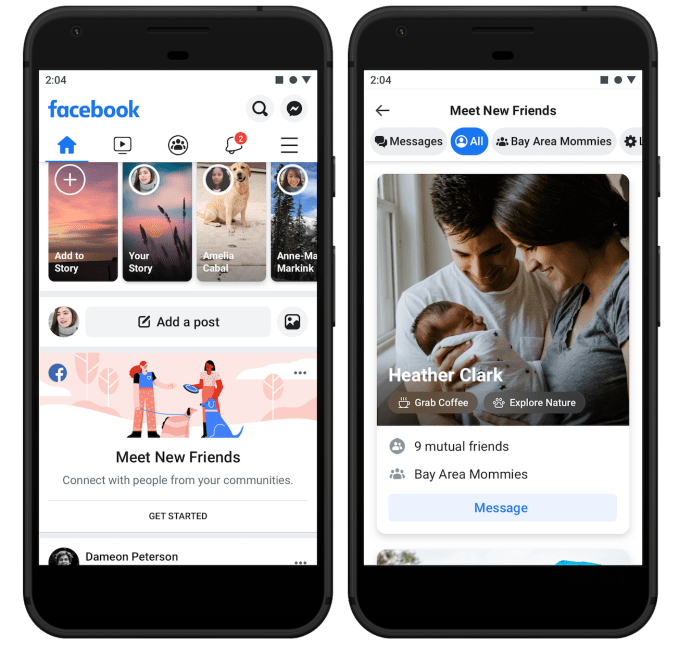
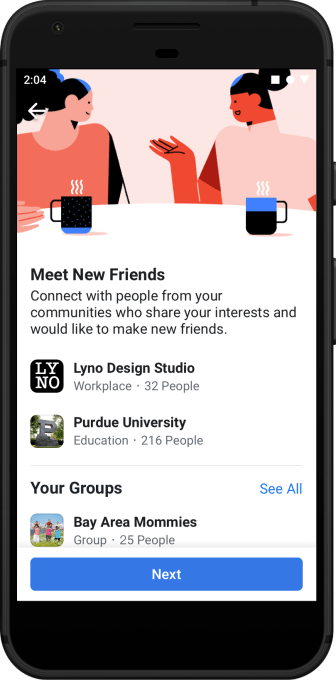 Fidji Simo, the head of Facebook’s main app, tells me Meet New Friends was based on emerging behaviors the company had spotted. “Developing relationships with people they didn’t already know is very different from the core use case of Facebook,” but she notes, “We’ve already seen that naturally happen in Groups, and Meet New Friends will make that a bit easier.”
Fidji Simo, the head of Facebook’s main app, tells me Meet New Friends was based on emerging behaviors the company had spotted. “Developing relationships with people they didn’t already know is very different from the core use case of Facebook,” but she notes, “We’ve already seen that naturally happen in Groups, and Meet New Friends will make that a bit easier.”
When users open Meet New Friends, they pick the communities through which they’re open to meeting new friends. For now they choose between schools, employers and locations, but Facebook will eventually add Groups too. In that sense it works a bit like Facebook Dating, which rolls out to 14 new countries today and opens to dating friends with its new Secret Crush feature.
Algorithms will sort potential connections by who is most relevant, such as those with mutual friends or shared interests, but you won’t get “matched” where both users have to state their interest in the other. Instead, users can just browse profiles, and then either send people a friend request (which might feel a bit out of the blue), or send them a single text-only message to a recipient’s dedicated Meet New Friends chat inbox. They can’t message that same person again until they respond (to prevent spamming), and the text-only limitation ensures no unsavory photos get blasted around. If they do reply, the thread moves to Facebook Messenger.
Meet New Friends will pit Facebook against a range of other apps, from local-focused Meetup and Nextdoor to verticalized apps like Hey Vina for women only to dating-affiliated apps like Bumble BFF. But Facebook benefits from its ubiquity, so users can try Meet New Friends without feeling embarrassed by downloading an app just to make them less lonely.
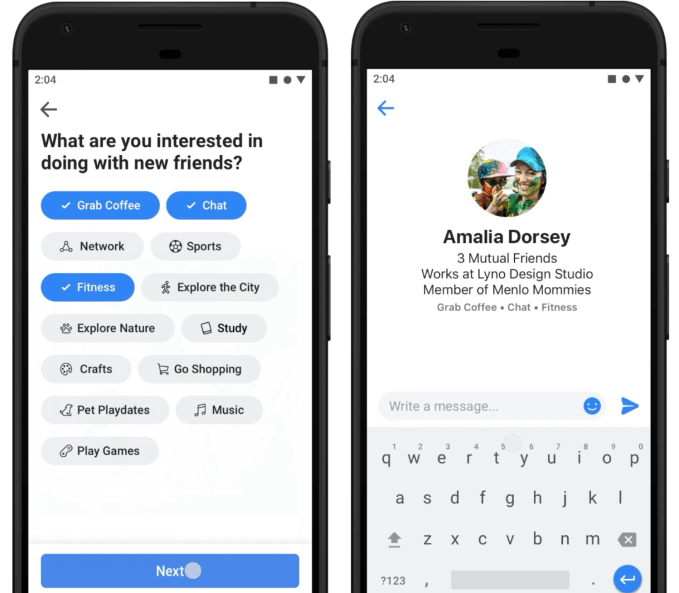
For years, the mildly creepy People You May Know feature has been a cornerstone of Facebook’s growth strategy. But it’s still just about recreating your offline social graph online. As Facebook strives to become more meaningful to people’s lives, fostering new friendships could give people a fuzzy feeling about the giant corporation.
Microsoft’s Mixer now lets streamers reward fans for participation, not just subscriptions
On game streaming platforms today, there’s really only one way to earn status within a creator’s community: you have to become a subscriber. Microsoft’s game streaming service Mixer is today aiming to offering a third path to status through loyalty and participation. In doing so, it hopes to better differentiate itself from larger rivals like Twitch and YouTube.
Channel Progression, as this new feature is called, is a system that rewards community members and a streamer’s fans for more than just their financial contributions. It also takes into account other activity within the channel and on Mixer as a whole.
Members can level up by participating in the stream’s chat, by their repeat visits, by using Skills (aka other forms of expression like stickers, effects and GIFs that are used in chats), and more. That means that viewers will be able to earn rewards and raise their rank by just participating — watching, chatting, following, subscribing, and later, through other actions, as well.
As streamers participate, they’ll rank up, gaining them bragging rights and other perks that will vary by their rank level. They can also check on their rank at any time by clicking on the “Your Rank” button at the bottom left corner of the chat box.
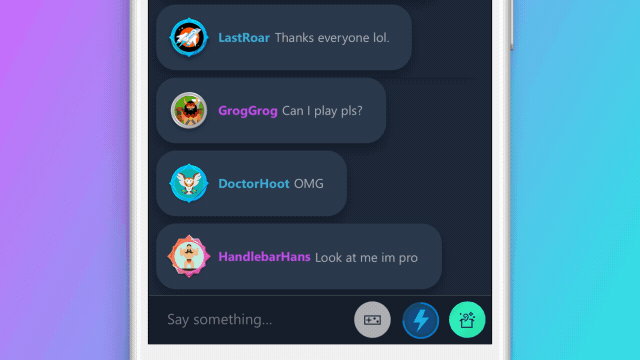
The feature is rolling out on Wednesday May 1, 2019 to all streamers on Mixer — not just Mixer Partner, as it’s designed to not only be a way for streamers to grow their own communities, but for Mixer itself to grow.
In the future, however, Mixer Partners will be able to also reward monetization actions, like subscribing, gift subscriptions, and for spending Embers (virtual currency).
The changes come at a time when there’s been a rise in complaints over how hard it is to get noticed on the leading game streaming site, Twitch. Some smaller streamers told The Verge last summer they spent years broadcasting to no one, and found it difficult to grow their community, despite the effort Twitch has made in this area. More recently, that’s included the launch of a four-person Squad Stream, to help creators get discovered.
Despite this, Twitch’s longtail continues to grow — according to a recent report from StreamElements, the top 1,000 Twitch channels were responsible for 57% of Twitch’s viewership hours in Q1 2019, and the longtail (those beyond the top 10,000 channels) was responsible for 20%. In total, Twitch hit 2.7 billion hours of content watched in Q1, the report claimed.
Mixer, by comparison, is much smaller. Its numbers may have quadrupled since Q1 2019, but that’s only going from 22 million hours watched to 89 million. It still has much, much further to go to catch up with YouTube Live, not to mention Twitch.
Mixer’s channel progression feature was originally announced in November as part of Mixer’s “Season 2” release. It launches tomorrow to all on Mixer.com on the desktop and will roll out to all other platforms in the weeks ahead.
Facebook Dating opens to friends with Secret Crush
Facebook built Dating to be privacy-safe, hoping to avoid the awkwardness of friends or family checking out your romance profile. But now Facebook has found a way to let you silently express your affection for a friend without them knowing unless they reciprocate.
Facebook Dating is opening in 14 more countries, bringing the total to 19. It will launch in the US before the end of the year. Dating brings with it a new feature called Secret Crush that expands it beyond strangers and friends-of-friends. Choose up to 9 friends you like-like. If they’ve opted into Facebook Dating, they’ll get a notification that some friend has a crush on them. If they add you as a Secret Crush too, you’re both notified and can chat on Messenger.
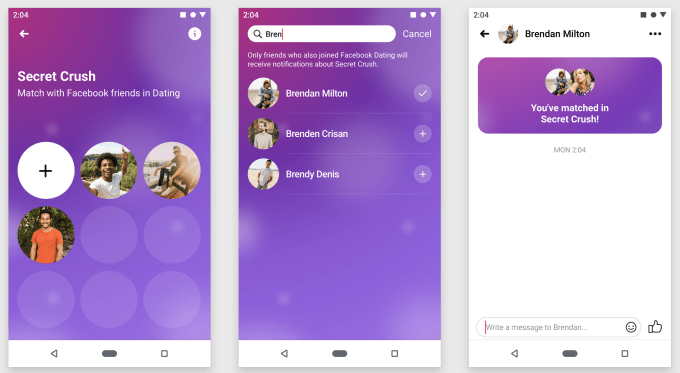
Facebook Dating product manager Charmaine Hung tells me that “I have 2000 Facebook friends. I’m not best friends with all 2000 people, and there’s a good chance that one of that could be a really good match with me. I trust them, I appreciate them, and I know we’re compatible. The only thing missing is knowing if we’re both interested in being more than just friends without the fear of rejection if you were to do this in real life.”
Facebook announced Dating at F8 a year ago and launched it in Colombia in September. Users opt-in, and then browse Events and Groups they’re part of for potential matches. They send them a text-only message based on something in their profile which goes to a special Dating inbox. And if that person reciprocates, they can chat and maybe meet up. Now it’s opening in the Philippines, Vietnam, Singapore, Malaysia, Laos, Brazil, Peru, Chile, Bolivia, Ecuador, Paraguay, Uruguay, Guyana, and Suriname.
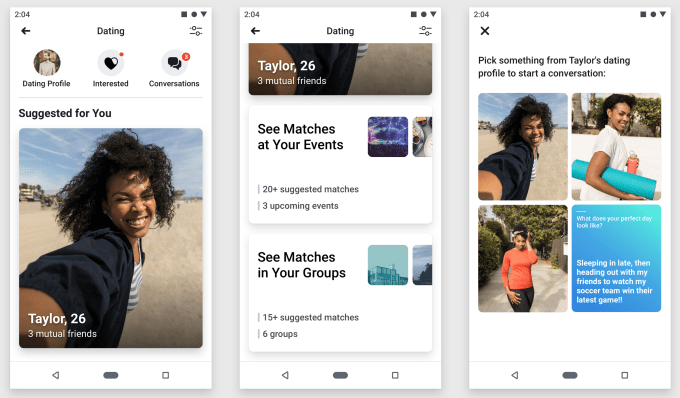
One concern with Secret Crush is that users might spam the feature by constantly adding a removing people from their list until they discover a match. That’s why Facebook will only let you sub out one person per day after you reach your initial limit of 9.
Currently there’s still no plan to monetize Dating, but that’s not the point. After years of scandals, Facebook needs to prove it deserves to be your social network. Mindlessly browsing the News Feed has proven to be exhausting and at times detrimental to health. But if the app can introduce you to your future spouse, or even just a summer fling, you might keep a place in your for Facebook too.
Instagram officially tests hiding Like counts
Would we feel less envious, shameful and competitive if Instagram didn’t tell us how many Likes a post received? That’s the idea behind Instagram now hiding Like counts from both a post’s viewers and its author as part of an experiment in Canada. A post’s creator can still open the Likers window to see the names of everyone who hearted their post, but they’d have to count them manually.
Even though Like totals would still impact how the algorithm ranks a post in the feed, if rolled out, the change would refocus Instagram on self-expression instead of being a popularity contest. Users might be less likely to delete a photo or video because it didn’t get enough Likes, or resort to their Finsta account to post something authentic but less “perfect.” It could make us less likely to envy-spiral because we wouldn’t see friends or influencers getting more Likes than us. And people might be more willing to post what truly represents their complicated identities because they’re not battling for the biggest Like count.

“Later this week, we’re running a test in Canada that removes the total number of likes on photos and video views in Feed, Permalink pages and Profile,” an Instagram spokesperson tells TechCrunch. “We are testing this because we want your followers to focus on the photos and videos you share, not how many likes they get.” The small percentage of Canadian users in the test will see a notice atop their feed warning them of “a change to how you see Likes.”
One big concern, though, is that influencers often get discovered for paid promotions or have their sponsored content measured by public Like counts or a screenshot of their Liker list. “We understand that this is important for many creators, and while this test is in exploratory stages, we are thinking through ways for them to communicate value to their brand partners,” an Instagram spokesperson tells TechCrunch.
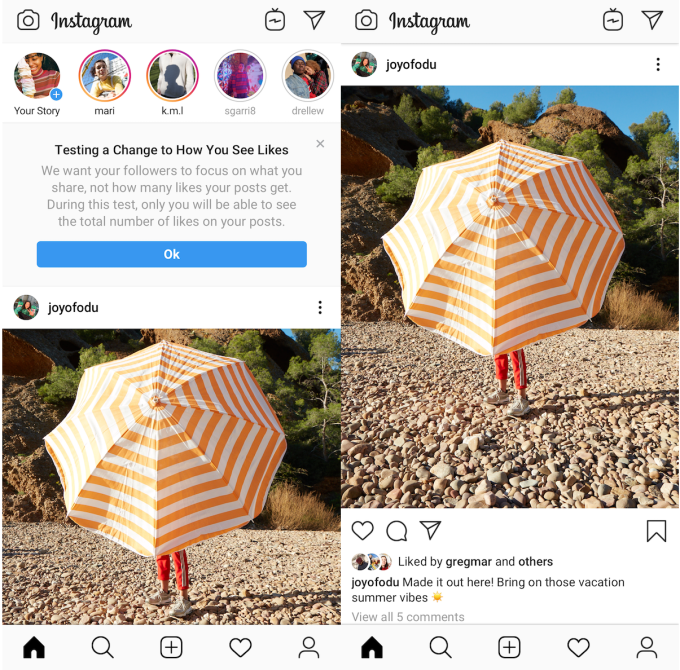
TechCrunch first reported two weeks ago that Instagram had prototyped hiding public Like counts, as spotted by Jane Manchun Wong. The company confirmed the feature had been built but not tested in the wild. The news immediately set off a wave of commentary from users. Many, while initially shocked, thought it would make Instagram usage healthier and cutback on some of the toxic anxiety produced by staring at the little numbers.
So why test in Canada? “Canadians are highly social and tech savvy, with over 24 million people connecting across our family of apps each month. We wanted to test this with a digitally savvy audience that has a thriving community on Instagram,” a company spokesperson told us.
It’s reassuring to see Instagram adding new well-being features after the departure of founders Kevin Systrom and Mike Krieger. Systrom in particular had been a big proponent of reducing envy and inauthenticity on social media, which was part of the impetus for launching Instagram Stories, where users could share unpolished looks at their lives. Before he left in September, Instagram rolled out its Your Activity dashboard showing the average time you spent per day on the app, plus a “You’re All Caught Up” warning that tells users they’ve seen all recent feed posts and can stop scrolling.
A 2013 study by Krasnova et al. discovered that 20 percent of envy-causing situations that experiment participants experienced happened on Facebook. They also determined that Facebook causes toxic envy, noting that “intensity of passive following is likely to reduce users’ life satisfaction in the long-run, as it triggers upward social comparison and invidious emotions.” Instagram, with its focus on imagery and manicured looks at our lives, might cause even more envy. Hiding Likes would be a strong step toward us judging ourselves less.
Workplace, Facebook’s enterprise edition, gets a reboot to boost activity and cut down on noise
At F-8 today, Facebook is unveiling a major redesign for its desktop app — the first big update it’s made since 2014 — and a refresh of its mobile apps as it begins to bring its many functions, features and apps under a more unified umbrella. And along with that, Workplace, its enterprise version, is also getting a renovation. Aimed at increasing access to different features like Groups, Chats and Notifications, the update brings their functionality closer together, and on top of that introduces more of Facebooks’s famous algorithm, to suggest people and groups tailored to you.
“We’ve redesigned the experiences so that the code bases remain the same,” Karandeep Anand, the head of Workplace, said of the new updates and how they relate to Facebook.
Workplace announced in February that it now has 2 million paying users, along with “millions” more using the free or Workplace for Good versions, and now the name of the game for the company is engagement.
Getting more people to use Workplace more regularly as part of their daily work life increases the likelihood that companies will continue using (and paying for) it — and crucially not jumping to a competitor. As Slack approaches its IPO and prepares itself for more public scrutiny, and Microsoft continues to double down on new features, that strategy is perhaps more important than ever.
To that end, the company today showed off a new desktop version of Workplace that gives it parity with the mobile app and Facebook’s updated consumer desktop experience.
We’re running a series of screenshots here of how the new pages on desktop look, and the second set of images are screenshots of the “old” Workplace, so that you can see how it was cleaned up.
[gallery ids="1819673,1819675,1819676,1819677,1819678,1819680,1819681,1819683,1819684"]
And here are some shots of the older version:
[gallery ids="1819753,1819752,1819751"]
On the UI side, the new design notably brings two key Workplace features — Groups and contacts for Chats — out of the right-rail graveyard, where many users are believed to have stopped looking years ago to ignore ads — and into the left column, which used to provide a menu of tools and further information about your organization. The idea is that, by putting them on the left, it will make it more likely for people to turn to these lists and engage with them more.
“We’re making usage significantly more tighter and coupled between posts and Groups,” said Anand. “The idea is to bring messaging into the same room as wider conversations.”
Notifications, meanwhile, is getting its own “inbox”, so to speak. This is a clever turn that essentially expands the list of actions that have happened that are relevant to you, so that you can click on each one and jump to a view of that relevant piece of content, separate from being in the main default page. This is a useful way for people who might be very busy to look quickly through a series of different updates without the distraction of looking at the rest of their Workplace feed.
Distraction is a theme here: another new update is that Workplace now has a “focus” mode in sections like Groups that take away the left navigation column so that you can look specifically at the content you are working on without lots of alerts from other groups, individuals or the company at large. Given the immense amount of distraction that we have these days from notifications, this could be a welcome change for some.
On top of the UI changes, Facebook is giving Workplace a bigger international twist as well. The app is now available in 46 languages, and now Facebook will be offering more auto-translation options to its users to leverage that.
There is also another level of changes taking place that are more under the hood but also interesting: Facebook is introducing more algorithmic features into Workplace, by tapping into your “work graph” to suggest people and groups that you might interact with.
Up to now, there was already some algorithmic tweaking to Workplace: admins could bump certain news items into people’s feeds so that they were seen by more employees; and similarly the newsfeed didn’t run in a chronological order but based on what you interacted with, which groups you were already a part of, and so on, to bring you content that was deemed more relevant.
Now that is being expanded to connections and groups. The aim here is pretty clear: by giving you a more tailored list of people and content, Workplace will hopefully keep your attention for longer. Anand says that it’s important for Facebook and Workplace to continue to keep parity in their codebases, but it’s moves like this one that underscore how Facebook aims to keep the ethos of the two products aligned as well.
Review: Oculus Quest could be the Nintendo Switch of VR
Facebook has bet a lot on its VR dream. The industry has become the butt of a few jokes in the past couple years as hype has deflated, but there’s been no question that the tech is interesting, the question has been whether it’s sustainably cool. Oculus made a gamble on the high-end three years ago, but the $399 standalone Quest is where they see whether that bet was worth it.
In a lot of ways, this is a VR headset built in the spirit of the Nintendo Switch.* Performance is secondary to the depth of user experience and ease of use. It’s vastly easier to get this out of the box and start playing with tracked VR than any other VR headset I’ve used. It takes minutes the first time you take it out of the box and seconds in subsequent uses.
You don’t need a PC, you don’t need to connect a cable to anything, you don’t need to stress. The Quest nails experience.

Things I like:
- Great overall experience, picking the headset up and getting into VR takes a minute.
- ^ That.
- ^^ That again.
- Great library of launch titles.
- Battery life is better than expected.
Things I don’t like:
- OLED screen suffers same pixelated look as original Rift, LCD displays in Rift S and Go appear crisper, especially for things like text legibility.
- Near-ear speakers are generally poor quality; you’ll probably want headphones.
- Total tracking volume for controllers could be better.
How does it feel?
The Insight tracking system does well for the most part, it’s the only choice for a standalone headset so there’s no point comparing it to the fidelity of outside-in tracking systems. It performs well and the headset-tracking was was generally flawless, the controller-tracking was a bit more mixed as the cameras frequently lost sight of the controllers during gameplay.
There are some cool little things that this tracking system integrates, like shifting to a passthrough camera when you walk outside of your Guardian safe space so you have a sense of where you’re at.
When it comes to hardware, the headset makes compromises i
The performance of the mobile chipset certainly doesn’t offer a PC experience but the user experience has been fine-tuned so well that you forgive its shortcomings. Oculus certainly seems to get the most of the Snapdragon 835, which powers the headset, but Rift users will realize within 10 seconds that this is a lower class of device even if some of the titles are the same. That’s not to say that the experiences look bad, but expectations that Oculus eeked desktop performance out of the chipset that powered the Galaxy S8 should be heavily tempered.

There are over 50 titles in the Quest store at launch. I got access to a handful including favorites like Beat Saber and Superhot VR. Oculus has a great line-up. The games may offer less fidelity in detail but they feel full-featured all the same.
The display and optics are adequate though things aren’t as crisp as one might hope, the pixel layout falls victim to the “screen-door effect” where you can basically see the space between pixels quite clearly. This isn’t the case with even the budget Oculus Go.
The battery life is better than I was expecting. Oculus says you can expect about 2 hours of heavy-gaming and 3 hours of media watching, this seems to be a conservative estimate based on my experience. This is still a machine that you leave plugged-in at all times in-between uses, using it while tethered to an external battery pack isn’t the worst though.
The headset may not be the most powerful, but it is doubtlessly the new flagship VR product from Facebook. The company outsourced design of its PC-powered Rift S headset to Lenovo because the high-end isn’t where Oculus needs to find new customers, the Quest is a bet on going mainstream and from my experience, it seems to be a worthwhile bet.
* Now, before you sound off in the comments. Yes, Nintendo has created a cardboard Labo VR holder for the Nintendo Switch, but the Nintendo Switch is just a Switch, it’s not the Switch of VR.
US border agents assert ‘broad unconstitutional’ power to search citizens’ devices
U.S. border officials are asserting “broad, unconstitutional authority” to conduct warrantless searches of travelers’ phones, tablets and laptops, according to a new court filing.
The findings, obtained from depositions and discovery filed in court by the American Civil Liberties Union on Tuesday, claim U.S. Customs and Border Protection (CBP) and Immigration and Customs Enforcement (ICE) are overreaching their powers to search traveler devices at the border without seeking a court-approved warrant.
Esha Bhandari, staff attorney with the ACLU’s Speech, Privacy, and Technology Project, said the agencies were “using the pretext of the border to make an end run around” the constitution.
“The border is not a lawless place, ICE and CBP are not exempt from the constitution, and the information on our electronic devices is not devoid of Fourth Amendment protections,” said Bhandari, citing the protection of free speech and warrantless searches.
“We’re asking the court to stop these unlawful searches and require the government to get a warrant,” she said.
The filing is the latest from a lawsuit filed by the ACLU alongside the Electronic Frontier Foundation by ten U.S. citizens and one permanent resident — including a NASA engineer and a journalist — whose devices were searched at the border without a warrant. In some cases, their devices were confiscated for months.
“The border is not a lawless place, ICE and CBP are not exempt from the constitution.”
Esha Bhandari, ACLU
The plaintiffs are asking the court to rule that the government must first have a warrant to search their devices, based off reasonable suspicion that a crime may have been committed.
The ACLU wants the court to rule without trial.
Border searches are on the rise. CBP searched more than 30,000 travelers’ devices last year, close to four-times the number from three years prior. But Homeland Security, which houses both CBP and ICE, has long claimed authority to search anyone arriving at the U.S. under the border search exception, a doctrine said to stretch 100 miles inland, encompassing dozens of America’s largest cities. Several appeals courts have sparred over the constitutionality of the exception — with the decision likely to end up at the Supreme Court.
According to its latest filing, the ACLU said border officials are searching devices without a warrant for a broad range of reasons, including enforcing tax, bankruptcy, environmental, and consumer protection laws.
The ACLU also said that ICE agents have searched the devices of a U.S. citizen if they are seeking information about a suspected undocumented person, and also claim the right to search the devices of journalists who are “known to have had contact with a suspected terrorist, where there is no suspicion that the reporter engaged in wrongdoing,” and any “foreign sources who are of interest to the U.S. government.”
The group also said devices are being searched for either intelligence gathering or advancing pre-existing investigations, and CBP staff will also consider requests from other law enforcement agencies — including foreign agencies — when carrying out searches.
Any data collected by CBP or ICE without a warrant can be shared with federal, state, local and foreign law enforcement, the ACLU said.
The filing also said CBP officers “may have accessed cloud-based content during searches of electronic devices,” despite a directive in April 2017 barring officers from accessing cloud-based data from a device.
Adam Schwartz, a senior staff attorney at the Electronic Frontier Foundation, said the government’s warrantless searches are “unconstitutionally broad.”
“ICE and CBP policies and practices allow unfettered, warrantless searches of travelers’ digital devices, and empower officers to dodge the Fourth Amendment when rifling through highly personal information contained on laptops and phones,” he said.
When reached, spokespeople for CBP and ICE did not immediately comment.
Review: Facebook’s Oculus Rift S is barely an upgrade
More than three years after Facebook released one of the biggest gambles in its existence, a virtual reality headset it paid billions to launch as its own, the company has grown more embattled but its moonshot VR flagship has grown safer.
Facebook’s sequel to the Oculus Rift is not the Rift 2, it is the Rift S. Just as the iPhone naming scheme denotes the tock to a tick rather than a full revolution; the latest product is a hardware update, albeit a pretty minor one, more of a 1.2 than a 2.0.
It wasn’t always going to be this way — the company’s founding CEO had other plans. But the Rift S represented a way for Facebook to push the accessibility of its most high-end headset and likely the profit margins of the cheaper-feeling headset, which does cost $399 versus the original Rift’s $349 price tag, a number that danced and dwindled its way down from a Rift + Touch launch price of $798 at the end of 2016.
[gallery ids="1819661,1819654,1819652"]
The hardware design isn’t really the story that Facebook and Oculus are pushing with the Rift S. The hardware is a product of sacrifices that give the entire headset a lower-end feeling than the Quest or Go, it was largely built by Lenovo after all; as such this release is mostly about the software advancements.
The built-in “Insight” tracking is the highlight and lowlight of the release. It’s undoubtably a downgrade from the full capabilities of its predecessor — while the headset tracks itself very well, I would frequently lose tracking on the controllers on the cameras’ peripheral– but it also makes the system considerably easier to set up and maintain. Gone are the external sensors and their damn driver updates, gone are the constant needs for recalibration when a headset was bumped out of place — this is a headset that learns from your space.
The external sensor system on the original Rift required three spaced out sensors in order to fully capture the total range of body motion. The headset only came with two sensors which minimized these capabilities and forced game developers to build titles that would constantly lead users to reorient themselves towards the sensors. No such reorienting is needed with the Rift S which brings the tracking cameras into the headset itself.
Features like the updated “Guardian” boundary setup and the passthrough camera that activates once you leave the safe space showcase some of the key learnings of the past few years and some of the added benefits of the onboard tracking. All of this feels very natural and mature.
While the headset’s onboard tracking feels great, the experience for controller tracking is more hit-or-miss. Common in-game motions like examining an object and turning the top of the controller away from you can lead to briefly obscuring the tracking rings and thus temporarily losing tracking. It always seems to recover, but there are moments in games where you are being chased and need to shoot behind you or grab something offscreen while maintaining focus on an object. These are moments where you see some short-sightedness in Oculus’s choice.
My first impressions of the Rift S were less than stellar, but after getting it in my home for some lengthy VR sessions, I’ve warmed up to it a little bit. It still doesn’t feel like a proper upgrade to a flagship headset that’s already three years old, but it is a more fine-tuned system that feels more evolved and dependable. There are still certainly some things I don’t like…
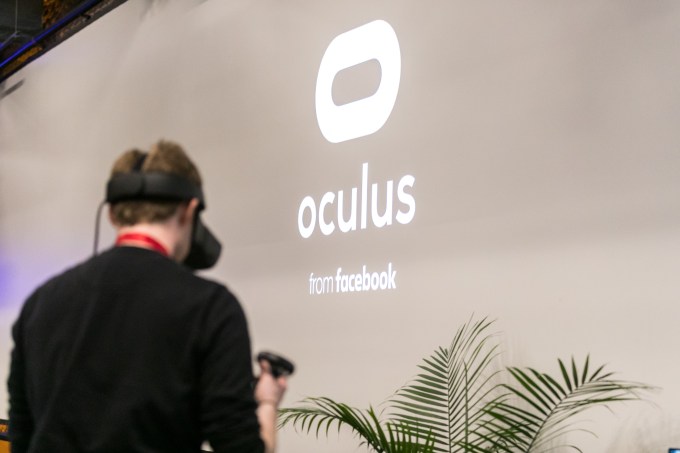
Things that are subpar:
- The controller tracking system isn’t robust enough for the demands of VR movements, you will notice and frequently feel the outside edge of the tracking boundary in intense gaming sessions.
- The lack of adjustable displays to account for the differing distances between people’s eyes means that the one-size-fits-all headset gives a less optimal experience for certain users. I am one of those users that falls just outside of that sweet spot, something that made the headset a bit less comfortable on the eyes than its predecessor for me.
- The original Touch controllers were better and more ergonomic, with the headset blinding me I put these controllers in the wrong hand roughly 50% of the time.
- The lack of built-in headphones was an annoying choice, the near-ear speakers are better than expected but don’t isolate you from the world, a concept that the entire headset is sort of built around.
- The face padding is far less comfortable or durable than the Oculus Go or Oculus Quest, something that feels a bit odd for the top-of-the-line experience.
Things that aren’t as subpar as I had feared:
- The switch from OLED to LCD panels feels like a downgrade on paper, but the way the sub-pixels are laid out on the higher resolution Rift S display gives a much more crisp image even if the LCD screen’s blacks feel a bit grayer. Running at 80hz versus 90hz isn’t a great choice.
- I like the flexible head straps of the rest of Oculus’s product line, but the halo design that Lenovo lifted from Sony feels quite comfortable here and given that it’s a PC-tethered system there aren’t unfortunate portability trade-offs like there were with the Mirage Solo headset.
- I still prefer the build on the previous generation Rift, but the headset feels less clanky than I detailed in my hands-on.
It’s a headset that will offer more pleasant on-boarding and usage to new customers, but for what is supposed to be the industry’s leading high-end headset, Oculus has taken a small step back in performance.
For new customer that are looking for something more high-end than the Quest, the device still offers a lot of advantages. You’ll have some time to make a choice, pre-orders are live for the headset today, but it doesn’t ship until May 21.
Oculus Quest and Rift S ship May 21, pre-orders go live today
Facebook’s new VR headsets, the Oculus Rift S and Quest, are both now live for pre-orders today at $399 and will ship May 21.
Oculus released the original Rift just over three years ago. Fast forward to the present and the Facebook VR product line has gotten more robust. The $199 Oculus Go offers a cheap arena to watch media content, Rift S offers a PC experience that can showcase complex gaming experiences while the Quest aims to be a good fit for novices looking for a portable VR experience.
Facebook hopes the Quest will bring in a new class of users into VR while the Rift S allows it to expand its concurrent reach on PC.
You can read reviews of both systems below:
Facebook Messenger will get desktop apps, co-watching, emoji status
To win chat, Facebook Messenger must be as accessible as SMS, yet more entertaining than Snapchat. Today, Messenger pushes on both fronts with a series of announcements at Facebook’s F8 conference, including that it will launch Mac and PC desktop apps, a faster and smaller mobile app, simultaneous video co-watching and a revamped Friends tab, where friends can use an emoji to tell you what they’re up to or down for.
Facebook is also beefing up its tools for the 40 million active businesses and 300,000 businesses on Messenger, up from 200,000 businesses a year ago. Merchants will be able to let users book appointments at salons and masseuses, collect information with new lead generation chatbot templates and provide customer service to verified customers through authenticated m.me links. Facebook hopes this will boost the app beyond the 20 billion messages sent between people and businesses each month, which is up 10X from December 2017.
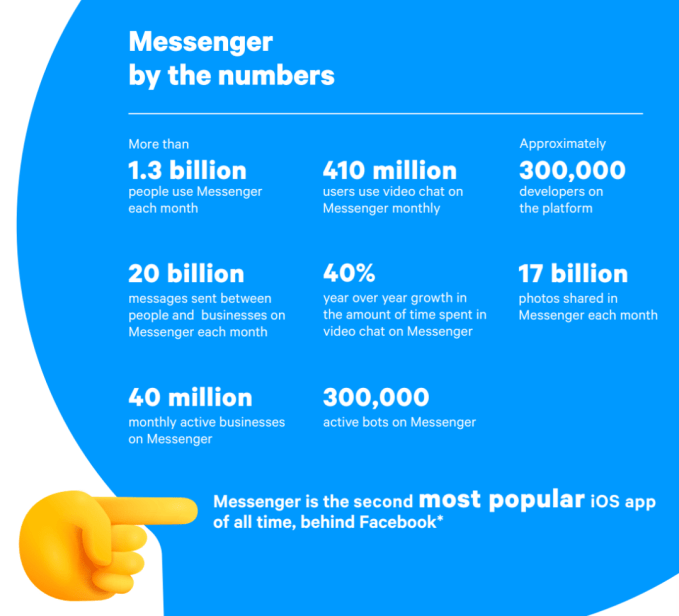
“We believe you can build practically any utility on top of messaging,” says Facebook’s head of Messenger Stan Chudnovsky. But he stresses that “All of the engineering behind it is has been redone” to make it more reliable, and to comply with CEO Mark Zuckerberg’s directive to unite the backends of Messenger, WhatsApp and Instagram Direct. “Of course, if we didn’t have to do all that, we’d be able to invest more in utilities. But we feel that utilities will be less functional if we don’t do that work. They need to go hand-in-hand together. Utilities will be more powerful, more functional and more desired if built on top of a system that’s interoperable and end-to-end encrypted.”
Here’s a look at the major Messenger announcements and why they’re important:
Messenger Desktop – A stripped-down version of Messenger focused on chat, audio and video calls will debut later this year. Chudnovsky says it will remove the need to juggle and resize browser tabs by giving you an always-accessible version of Messenger that can replace some of the unofficial knock-offs. Especially as Messenger focuses more on businesses, giving them a dedicated desktop interface could convince them to invest more in lead generation and customer service through Messenger.
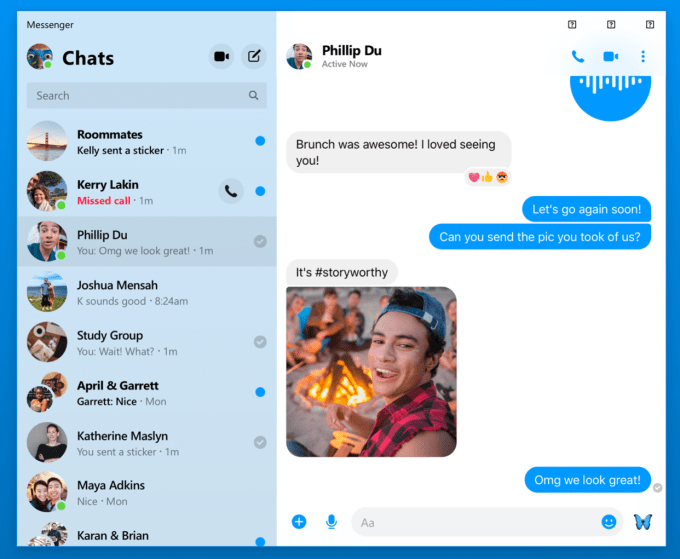
Facebook Messenger’s upcoming desktop app
Project Lightspeed – Messenger is reengineering its app to cut 70 mb off its download size so people with low-storage phones don’t have to delete as many photos to install it. In testing, the app can cold start in merely 1.3 seconds, which Chudnovsky says is just 25 percent of where Messenger and many other apps are today. While Facebook already offers Messenger Light for the developing world, making the main app faster for everyone else could help Messenger swoop in and steal users from the status quo of SMS. The Lightspeed update will roll out later this year.
Video Co-Watching – TechCrunch reported in November that Messenger was building a Facebook Watch Party-style experience that would let users pick videos to watch at the same time as a friend, with reaction cams of their faces shown below the video. Now in testing before rolling out later this year, users can pick any Facebook video, invite one or multiple friends and laugh together. Unique capabilities like this could make Messenger more entertaining between utilitarian chat threads and appeal to a younger audience Facebook is at risk of losing.
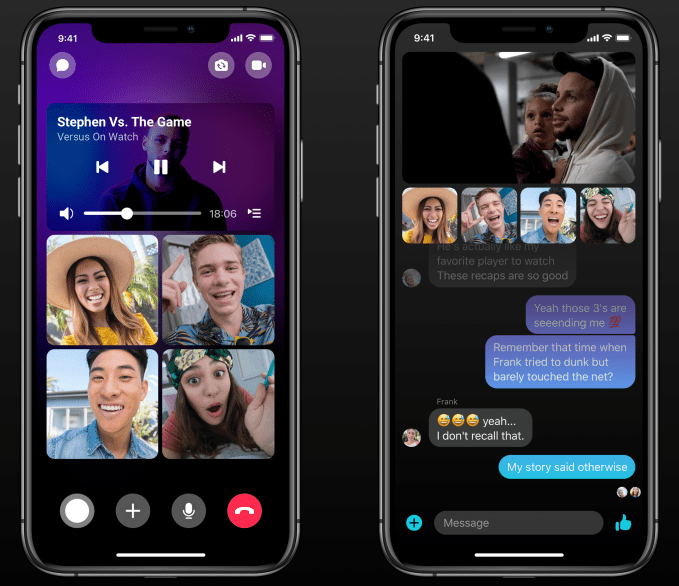
Watch Videos Together on Messenger
Business Tools – After a rough start to its chatbot program a few years ago, where bots couldn’t figure out users’ open-ended responses, Chudnovsky says the platform is now picking up steam with 300,000 developers on board. One option that’s worked especially well is lead-generation templates, which teach bots to ask people standardized questions to collect contact info or business intent, so Messenger is adding more of those templates with completion reminders and seamless hand-off to a live agent.
To let users interact with appointment-based businesses through a platform they’re already familiar with, Messenger launched a beta program for barbers, dentists and more that will soon open to let any business handle appointment booking through the app. And with new authenticated m.me links, a business can take a logged-in user on their website and pass them to Messenger while still knowing their order history and other info. Getting more businesses hooked on Messenger customer service could be very lucrative down the line.
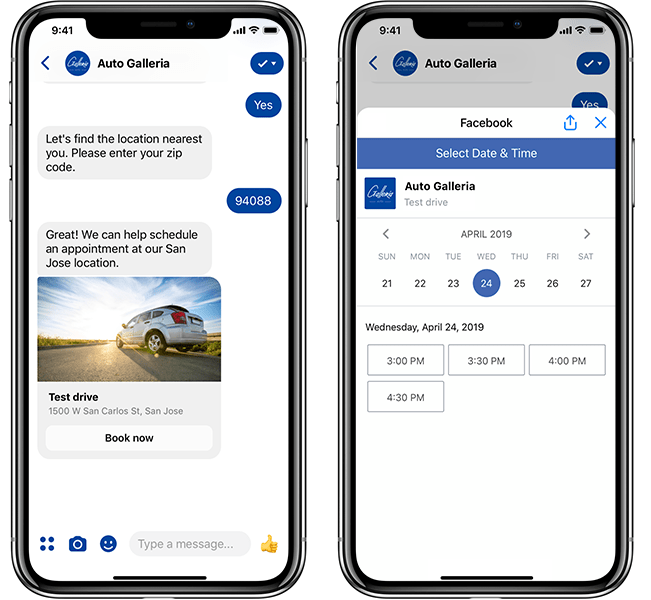
Appointment booking on Messenger
Close Friends and Emoji Status – Perhaps the most interesting update to Messenger, though, is its upcoming effort to help you make offline plans. Messenger is in the early stages of rebuilding its Friends tab into “Close Friends,” which will host big previews of friends’ Stories, photos shared in your chats, and let people overlay an emoji on their profile pic to show friends what they’re doing. We first reported this “Your Emoji” status update feature was being built a year ago, but it quietly cropped up in the video for Messenger Close Friends. This iteration lets you add an emoji like a home, barbell, low battery or beer mug, plus a short text description, to let friends know you’re back from work, at the gym, might not respond or are interested in getting a drink. These will show up atop the Close Friends tab as well as on location-sharing maps and more once this eventually rolls out.

Messenger’s upcoming Close Friends tab with Your Emoji status
Facebook Messenger is the best poised app to solve the loneliness problem. We often end up by ourselves because we’re not sure which of our friends are free to hang out, and we’re embarrassed to look desperate by constantly reaching out. But with emoji status, Messenger users could quietly signal their intentions without seeming needy. This “what are you doing offline” feature could be a whole social network of its own, as apps like Down To Lunch have tried. But with 1.3 billion users and built-in chat, Messenger has the ubiquity and utility to turn a hope into a hangout.
Altice USA buys digital news network Cheddar for $200M
Cable television provider Altice USA has confirmed plans to pay $200 million for the millennial-focused, digitally-native news network Cheddar in all-cash, or all-cheddar, rather, deal. The price tag comes at a 25 percent premium to the media startup’s $160 million Series D valuation.
Jon Steinberg, the co-founder and chief executive officer of Cheddar and former president and chief operating officer of BuzzFeed, will become president of Altice News. Altice, an existing Cheddar investor, plans to leverage Cheddar’s broadcasts and CheddarU, a growing network of 1,600 screens on 600 college campuses, to expand its portfolio of news businesses.
“Our goal is to make Altice News a leader in local, business, national and international news everywhere,” Steinberg said in a statement. “The Altice team and Altice Way are as entrepreneurial as it gets with amazing markets, world-class local and international news, an amazing broadband network, and a soon to launch mobile offering.”
Cheddar declined to provide further comment.
Altice News, a new unit born out of the Cheddar acquisition, will include Cheddar, News 12 Networks and international and current affairs news network i24NEWS.
Founded in 2016, the New York-headquartered business operates its flagship business newscast on the trading floor of the New York Stock Exchange, as well as three other programs at its studio in New York’s Flatiron Building, WeWork Vine in Hollywood and the White House.
The company, dubbed the ‘CNBC of the internet,’ focuses on business news and the top headlines with 19 hours of programming per day. In a short time, the “fast-paced, young, non-partisan general and headline news network” has inked key partnerships to become widely available across platforms. Currently, its programs are viewable in 40 million homes on Sling TV, DirecTV NOW, Hulu, YouTube TV, Sony PlayStation Vue, Snapchat, fuboTV, Philo, Amazon, Twitch, Twitter, Facebook and 60 percent of smart TVs in the U.S. Cheddar attracts 400 million video views per month.
Cheddar had raised a total of $54.5 million in equity funding across four financings. Its investors include Lightspeed Venture Partners, Raine Ventures, Goldman Sachs, Liberty Global, Comcast Ventures, AT&T, Amazon, Antenna Group, Ribbit Capital, The New York Stock Exchange, Altice USA, 7 Global Capital, and Dentsu Ventures. Here’s a closer look at Cheddar’s funding history, per PitchBook:
- February 2016 Series A: $3 million at a $15 million valuation
- September 2016 Series B: $10M | $40M
- May 2017 Series C: $19M | $84M
- March 2018 Series D: $22.5M | $160M
The transaction is expected to close in the next two months.
“Cheddar has demonstrated an innovative approach to live news while building an engaged audience, solid followership and a strong brand,” Altice CEO Dexter Goei said in a statement. “As one of Cheddar’s early investors, we have enjoyed our partnership with Jon and admire the entrepreneurial spirit, energy and smart disruptive mentality that he brings to the news business.”
The deal represents a rare outcome for a digital media startup, a sector plagued by sudden shutdowns and slipping revenue figures. Mic, a similarly millennial-focused news outlet, laid off most of its staff last year before being acquired by Bustle for peanuts. The business was well-funded by venture capitalists, raising a total of $60 million before falling victim to Facebook’s 2017 algorithm change.
There’s more where that came from. Vice earlier this year confirmed plans to cut 250 jobs, BuzzFeed is laying 15 percent of its staff and Verizon Media Group (TechCrunch’s parent company) laid off 10 percent of its workforce in January. Just this week Brit&Co, a digital media brand catering to young women, began laying off a majority of its staff after an M&A deal failed to come together at the last moment, according to Recode.
Docker looks to partners and packages to ease container implementation
Docker appears to be searching for ways to simplify the core value proposition of the company — creating, deploying and managing containers. While most would agree it has revolutionized software development, like many technology solutions, it takes a certain level of expertise and staffing to pull off. At DockerCon, the company’s customer conference taking place this week in San Francisco, Docker announced several of ways it could help customers with the tough parts of implementing a containerized solution.
For starters, the company announced a Beta of Docker Enterprise 3.0 this morning. That update is all about making life simpler for developers. As companies move to containerized environments, it’s a challenge for all but the largest organizations like Google, Amazon and Facebook, all of whom have massive resource requirements and correspondingly large engineering teams.
Most companies don’t have that luxury though and Docker recognizes if it wants to bring containerization to a larger number of customers, it has to create packages and programs that make it easier to implement.
Docker Enterprise 3.0 is a step toward providing a solution that lets developers concentrate on the development aspects, while working with templates and other tools to simplify the deployment and management side of things.
The company sees customers struggling with implementation and how to configure and build a containerized workflow, so it is working with Systems Integrators to help smooth out the difficult parts. Today, the company announced Docker Enterprise as a Service with the goal of helping companies through the process of setting up and managing a containerized environment, using the Docker stack and adjacent tooling like Kubernetes.
The service provider will take care operational details like managing upgrades, rolling out patches, doing backups, and undertaking capacity planning — all of . those operational tasks, which require a high level of knowledge around enterprise container stacks.
Capgemini will be the first go-to-market partner. “Capgemini has a combination of automation, technology tools, as well as services on the back end that can manage the installation, provisioning and management of the enterprise platform itself in cases where customers don’t want to do that, and they want to pay someone to do that for them,” Scott Johnston, chief product officer at Docker told TechCrunch.
The company has released tools in the past to help customers move legacy applications into containers without a lot of fuss. Today, the company announced a solution bundle called Accelerate Greenfield, a set of tools designed to help customers get up and running as a container-first development companies.
“This is for those organizations that may be a little further along. They’ve gone all in on containers committing to taking a container-first approach to new application development,” Johnston explained. He says this could be cloud native microservices or even a LAMP stack application, but point is that they want to put everything in containers on a container platform.
Accelerate Greenfield is designed to do that. “They get the benefits where they they know that from the developer to the production end point, it’s secure. They have a single way to define it all the way through the lifecycle. They can make sure that it’s moving quickly, and they have that portability built into the container format, so they can deploy [wherever they wish.],” he said.
These programs and products are all about providing a level of hand-holding, either by playing a direct consultative role, working with a systems integrator or providing a set of tools and technologies to walk the customer through the containerization lifecycle. Whether they provide a sufficient level of help that customers require is something we will learn over time as these programs mature.
Docker updates focus on simplifying containerization for developers
Over the last five years, Docker has become synonymous with software containers, but that doesn’t mean every developer understands the technical details of building, managing and deploying them. At DockerCon this week, the company’s customer conference taking place in San Francisco, it announced new tools that have been designed to make it easier for developers, who might not be Docker experts, to work with containers.
As the technology has matured, the company has seen the market broaden, but in order to take advantage of that, it needs to provide a set of tools that make it easier to work with. “We’ve found that customers typically have a small cadre of Docker experts, but there are hundreds, if not thousands, of developers who also want to use Docker. And we reasoned, how can we help them get productive very, very quickly, without them having to become Docker experts,” Scott Johnston, chief product officer at Docker told TechCrunch.
To that end, it announced a Beta of Docker Enterprise 3.0, which includes several key components. For starters, Docker Desktop Enterprise lets IT set up a Docker environment with the kind of security and deployment templates that make sense for each customer. The developers can then pick the templates that make sense for their implementations, while conforming with compliance and governance rules in the company.
“These templates already have IT-approved container images, and have IT-approved configuration settings. And what that means is that IT can provide these templates through these visual tools that allow developers to move fast and choose the ones they want without having go back for approval,” Johnston explained.
The idea is to let the developers concentrate on building applications, and the templates provide all the Docker tooling pre-built and ready to go, so they don’t have to worry about all of that.
Another piece of this is Docker Applications, which allows developers to build complex containerized applications as a single package and deploy them to any infrastructure they wish — on-prem or in the cloud. Five years ago when Docker really got started with containers, they were a simpler idea, often involving just a single one, but as developers broke down those larger applications into microservices, it created a new level of difficulty, especially for operations who had to deploy these increasingly large sets of application containers.
“Operations can now programmatically change the parameters for the containers, depending on the environments without having to go in and change the application. So you can imagine that ability lowers the friction of having to manage all these files in the first place,” he said.
The final piece of that is the orchestration layer and the popular way to handle that today is with Kubernetes. Docker has created its own flavor of Kubernetes, based on the open source tool. Johnston says, as with the other two pieces, the goal here is to take a powerful tool like Kubernetes and reduce the overall complexity associated with running it, while making it fully compatible with a Docker environment.
For that, Docker announced Docker Kubernetes Service (DKS), which has been designed with Docker users in mind including support for Docker Compose, a scripting tool that has been popular with Docker users. While you are free to use any flavor of Kubernetes you wish, Docker is offering DKE as a Docker-friendly version for developers.
All of these components have one thing in common besides being part of Docker Enterprise 3.0. They are trying to reduce the complexity associated with deploying and managing containers and to abstract away the most difficult parts, so that developers can concentrate on developing without having to worry about connecting to the technical underpinnings of building and deploying containers. At the same time, Docker is trying to make it easier for the operations team to manage it all. That is the goal, at least. In the end, DevOps teams will be the final judges on how well Docker has done, once these tools become generally available later this year.
Purchase a Startup Alley exhibitor package for Disrupt SF 2019
We’re in hot pursuit of bold exhibitionists. It’s time to show the world your stuff. By that we mean it’s time to secure your spot in Startup Alley, the exhibition floor at the very heart of Disrupt San Francisco 2019, which takes place on October 2-4. Simply buy a Startup Alley Exhibitor Package to place your early-stage startup in the path of more than 10,000 influential technologists, founders, investors and media.
Startup Alley epitomizes world-class networking and opportunity. It’s where hundreds of early-stage startups showcase their tech and talent to an enthusiastic, targeted audience. And it’s where people make connections that can potentially change the course of their future.
Here’s just one example. While exhibiting in Startup Alley, TestCard received media coverage from several different outlets. Luke Heron, the company’s CEO, said that the article helped to push TestCard in the right direction:
The coverage we received while exhibiting in Startup Alley — among all these other fantastic startups — has a hugely positive impact when you’re fundraising.
He should know, because the company went on to secure $1.7 million in funding. That’s some hefty ROI right there.
What do you get with a Startup Alley Exhibitor Package? Excellent question. It starts with three Founder Passes, one day to exhibit in Startup Alley and access to the Startup Alley Exhibitor lounge. Your early-stage startup can represent any tech category, like AI/Machine Learning, Biotech/Healthtech, Blockchain, Fintech, Mobility, Privacy/Security, Retail/E-commerce, Robotics/IoT/Hardware, SaaS, Social Impact/Education and more.
Your passes are good for the three full days of Disrupt and provide access to all content (including the Startup Battlefield competition), more than 1,000 startups and sponsors in Startup Alley, interactive workshops and the full attendee list (through the Disrupt mobile app), along with a list of attending media outlets.
Hold on, startup fans, there’s more. You can use CrunchMatch to set up meetings with investors or other attendees, attend networking parties, have a shot at being our Startup Battlefield Wild Card winner and get fantastic discounts on hotel rooms in San Francisco. After the show ends, you’ll be able to access exclusive Disrupt video content. Note: You must be a verified early-stage (pre-series A) startup to exhibit in Startup Alley.
One more thing. If you think your startup’s the best in one of our featured categories, why not apply to be in the TC Top Pick program? You’ll get to exhibit for free — and who doesn’t love free?
Disrupt San Francisco 2019 takes place October 2-4. This is your chance to stake your claim in Startup Alley and take your company to the next level. Go ahead and buy your Startup Alley Exhibitor Package now — while you still can.
Is your company interested in sponsoring or exhibiting at Disrupt SF? Contact the sponsorship sales team by filling out this form.
Glovo, the on-demand ‘deliver anything’ local app, raises $169M Series D
Glovo, the Spain-headquartered on-demand delivery app that has similarities to Postmates in the U.S., has raised $169 million (€150m) in Series D funding. Lakestar led the round alongside Drake, owner of global pizza franchise Papa John’s.
Idinvest Partners and Korelya Capital also participated, bringing total raised to approximately $322 million. The company last raised funding ten months ago: a $134 million Series C round from Seaya Ventures, Cathay Innovation and Rakuten Capital.
Founded in January 2015 by Oscar Pierre and Sacha Michaud, Glovo offers a ‘shop on your behalf’ app that promises to let you order anything locally on-demand and have it delivered “within minutes”. This includes food items — the company is known for its McDonald’s deliveries in Spain — and non-takeout food and other verticals, such as groceries and pharmaceuticals.
The fast-growing company claims more than 5.5 million unique users and 16,000 associated partners, and now operates in 124 cities across 21 countries, including EEMEA, LATAM, and most recently in Sub Saharian Africa.
The startup says it currently employs over 1,000 people globally, with over 400 people in its Barcelona HQ. A classic gig worker setup: Glovo has 35,000 active “Glovers” on its platform (that’s “self-employed” couriers, to you and me).
Glovo says it will use this injection of funding to bolster global growth, which has been dramatically picking up pace (although, with some reported bumps in the road). CEO Oscar Pierre tells me the company launched in 18 new countries in 2018. There are also plans to further innovate around on-demand groceries, including creating “dark supermarkets” that operate alongside the app’s marketplace of local supermarket chains.
Explains Pierre: “Our Darkstores are urban micro-fulfillment centers located in central areas of a city. They allow us to fully control the value chain and offer the best UX, with a delivery of around 20 minutes. They are run 24 hours a day by Glovo employees whose role is to pick and pack customer orders and have them ready for when the courier arrives. We have launched the offering in Barcelona and Madrid so far and we are still learning and analyzing the results”.
In addition, Glovo will continue to throw more engineers and technology at the problem of optimising on-demand delivery. The company recently hired VP of engineering Mustafa Sezgin, who was an engineering leader at Uber prior to joining.
Pierre says tech is being developed to continue improving the efficiency of Glovo’s “delivery and dispatching capabilities to building a world-class mobile product that exposes everything in a city at the push of a button”. To support this, he intends to grow the tech and data team to over 300 engineers in the next 18 months.
“Today, more than 70 percent of our business is food, followed by groceries, courier and pharmacy,” adds Pierre. “Our vision is to make everything in a city instantly available through the app, and we want to expand into other areas beyond delivery (services, reservations, etc) soon”.
Meanwhile, I’m told Glovo’s most successful markets in terms of orders are Spain (Madrid & Barcelona), Argentina (Buenos Aires), Peru (Lima) and Italy (Milan). Its most successful markets in terms of growth last month (ie new customer acquisition) outside of the above were Costa Rica (San José), Guayaquil (Ecuador), Ukraine (Kiev), Turkey (Istanbul) and Romania (Bucharest).
Daily Crunch: The end of Anki
The Daily Crunch is TechCrunch’s roundup of our biggest and most important stories. If you’d like to get this delivered to your inbox every day at around 9am Pacific, you can subscribe here.
1. Cozmo maker Anki is shutting its doors
No one ever said consumer robots were easy. But Anki’s actually made a pretty strong go of it, all things considered.
“We’ve shipped millions of units of product and left customers happy all over the world while building some of the most incredible technologies pointed toward a future with diverse AI and robotics driven applications,” the company said. “But without significant funding to support a hardware and software business and bridge to our long-term product roadmap, it is simply not feasible at this time.”
2. Alphabet misses on Q1 revenues of $36.3B; EPS of $9.50 weighed down by the $1.7B European fine
Overall, it was a tough quarter for the company, indicating struggles with its growth.
3. Why did last night’s ‘Game of Thrones’ look so bad? Here comes the science!
For what it’s worth, I didn’t have any trouble watching Sunday’s climactic battle episode of “Game of Thrones” — but it seems plenty of other viewers did.
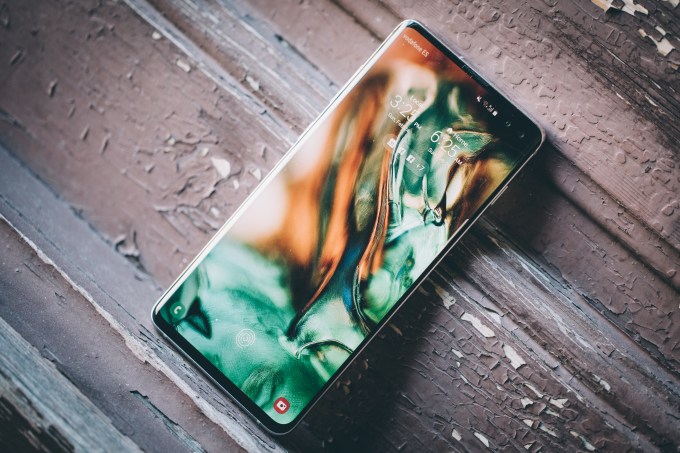
4. Samsung sees Q1 profit plummet 60 percent
Samsung said that sales of its new Galaxy S10 smartphone were “solid,” but it admitted that its memory chip and display businesses — so often the most lucrative units for the company — didn’t perform well.
5. Utah’s Divvy raises $200M to eliminate expense reports
Divvy only launched its platform, which allows customers to send and request funds, create virtual credit cards, manage team spending and more, in January 2018. Its valuation has grown 1,000 percent since then, across three rounds of equity funding.
6. Twitter announces new content deals with Univision, The Wall Street Journal and others
The spotlight has moved on from Twitter’s video strategy, but the company is still making deals.
7. What we want to know in the We Company (WeWork) S-1
With news that the We Company (formerly known as WeWork) has officially filed to go public, there’s a big question on everyone’s mind: Is this the next massive startup win or a house of cards waiting to be toppled by the glare of the public markets? (Extra Crunch membership required.)

